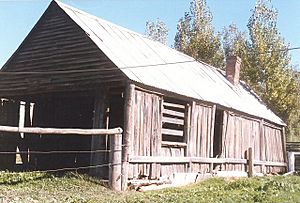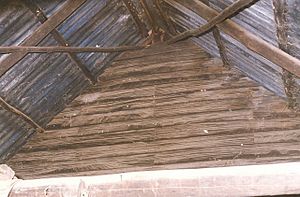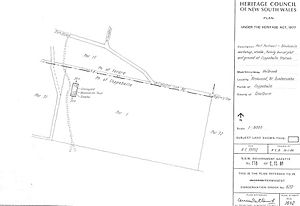Coppabella Blacksmith Shop facts for kids
Quick facts for kids Coppabella Blacksmith Shop |
|
|---|---|
 |
|
| Location | Rosewood, Greater Hume Shire, New South Wales, Australia |
| Built | 1863–1863 |
| Official name: Coppabella Blacksmith Shop, Stables and Burial Plot; Coppabella Station; Coppit Billy | |
| Type | state heritage (complex / group) |
| Designated | 2 April 1999 |
| Reference no. | 620 |
| Type | Blacksmithy |
| Category | Manufacturing and Processing |
| Lua error in Module:Location_map at line 420: attempt to index field 'wikibase' (a nil value). | |
The Coppabella Blacksmith Shop is a very old and important building in Rosewood, Australia. It was built around 1863 and was once part of a large farm called Coppabella Station. This special place also includes old stables and a family burial plot. It's protected because it shows us how people lived and worked a long time ago.
Contents
A Look Back: History of Coppabella
Early Days and First Settlers
The land where Coppabella stands was first given to Henry Osborne in 1837. A year later, he sold it to James Robinson. James Robinson was the first person to settle in the Tumbarumba area.
James Robinson and his wife had eight daughters and one son. Their son later took over the farm after James passed away in 1868. Because the family was so large, Coppabella became the main social spot in the area for many years. People would gather there for events and visits.
Changing Hands and New Owners
In 1872, the property was divided up. The main part was sold to Henry Whitty, who was a nephew of James Robinson's son.
Later, in 1876, the Rial brothers bought the property. However, the Bank of Australasia eventually took it over. We don't know much about who owned the property after that until 1920. In that year, Mr. Baker sold Coppabella to the Tupra Pastoral Company, which was owned by the Creswick family from Melbourne.
Protecting a Piece of History
In 1983, after Sir Alex Creswick died, his family sold Coppabella to Australian Newsprint Mills. This company makes paper for newspapers.
By 1985, people in the community became worried about the future of the site. The timber industry was growing, and many old farms were being cleared to plant pine trees. There was a chance that Coppabella could be cleared too.
To protect the site, an emergency order was put in place in August 1985. After talking with the owners, Australian Newsprint Mills, they agreed to help protect the site. A special order was placed in December 1986 to keep it safe.
In 1987, Australian Newsprint Mills asked for a report to check the old buildings. They wanted to know what work was needed to fix them. During 1988 and 1989, important repair work was done on the site.
The site was officially protected by a Permanent Conservation Order in December 1988. It was then added to the State Heritage Register on April 2, 1999. This means it's a very important historical place in New South Wales.
What You'll See: Description of the Site
Coppabella is located near Rosewood, about 50 kilometers east of Holbrook. It's close to Tumbarumba in the Snowy Mountains. The site includes three main parts: a blacksmith workshop, stables, and a family burial plot.
The Blacksmith Workshop
The blacksmith's workshop is a rectangular building made of timber. The walls are built from split wooden slabs. These slabs fit into the top and bottom wooden beams. The main posts holding up the building are set into the ground.
The roof is made of corrugated galvanised iron, which is a type of metal sheeting. It's supported by an original frame made from stringy bark saplings (young trees). The triangular parts of the roof at each end, called gables, are made of hand-split weatherboards. The floor inside is just earth. A brick chimney goes up through the roof.
- How they worked: Horses that pulled buggies (sulky horses) were shod (had horseshoes put on) inside the main room. Larger draft horses were shod outside in the yard, if the weather was good. Water was brought from a reservoir on a nearby hill through pipes. It flowed into a wooden barrel, which was then carried to the blacksmith's shop.
- Inside the shop: You can still see rough workbenches along the walls. The forge, which is where the blacksmith heated metal, stands near the north wall. There's a large bellows, a tool used to pump air into the forge to make the fire hotter. This bellows is very old and has a label that says "JOHN C. ONIONS, BRADFORD STREET, BIRMINGHAM." The forge area is full of old items like wheels, horseshoes, and tools used by blacksmiths. These tools are very special because many are handmade and show how skilled the blacksmiths were.
The Stables
The stables were originally made of weatherboard, but parts of them have been covered with metal sheeting. The building has a timber frame with an impressive central walkway lined with wooden posts. This walkway has stone paving. The horse stalls are separated by tall wooden slab partitions. The ceiling of the stables, which is also the floor of the hayloft above, is made of bark supported by poles.
The Family Burial Plot
To the north-east of the blacksmith shop and stables is the Robinson family burial plot. There are three graves here, with two headstones still standing. These headstones are made from local granite. The plot is surrounded by a railed fence and shaded by elm trees. The graves belong to James Robinson, who died in 1878, and James Dawling Robinson, who died in 1868. Next to the graves are several non-native trees that were planted along the original driveway to the property.
Why Coppabella is Special: Heritage Listing
Coppabella Station is very important to the history of New South Wales. It was the first large farm in the Tumbarumba region and played a big role in the local community. The blacksmith shop, stables, and graves date back to when the first settlers arrived.
These buildings show us old and rare ways of building. They used hand-cut timbers, bark, and corrugated iron. The blacksmith workshop, stables, and graves were built around 1863 and are still mostly in their original condition. They haven't been changed much since they were first built.
Because of its historical importance and unique construction, the Coppabella Blacksmith Shop was added to the New South Wales State Heritage Register on April 2, 1999.



